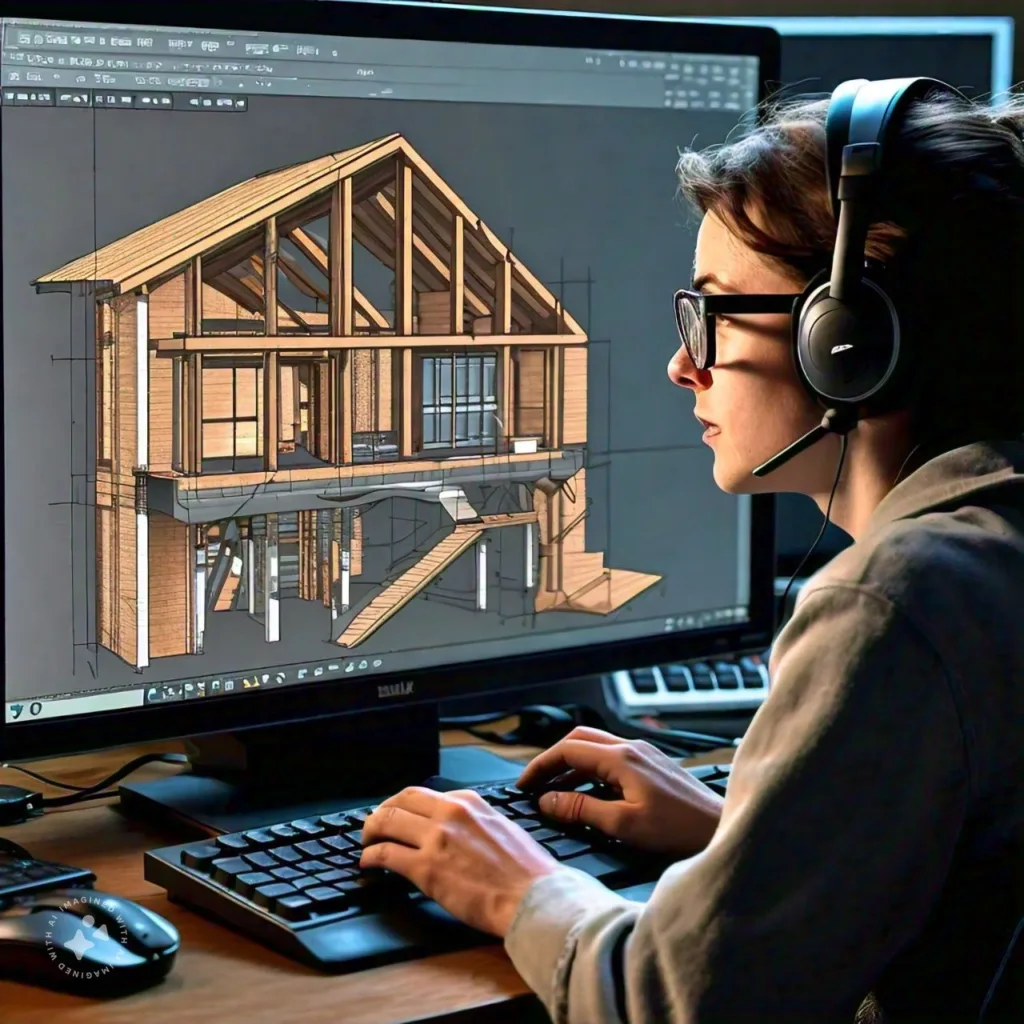Introduction
In architectural and design projects, elevations are crucial for conveying the vertical dimensions and external appearances of buildings. AutoCAD is an ideal tool for drafting these detailed elevation drawings with precision and clarity. Whether you’re creating elevations for residential, commercial, or industrial projects, understanding how to use AutoCAD effectively will help you produce professional-quality elevations. This article provides a step-by-step guide to creating building elevation in AutoCAD, covering essential tools and techniques.
Table of Contents
What Are Building Elevations?
Elevations are orthographic projections that show the vertical side of a building, giving detailed views of the exterior. Unlike floor plans, which show the layout from a top-down perspective, elevations provide insight into the height, design elements, materials, and overall structure of a building.
Elevations typically include key elements such as:
- Dimensions: Heights of walls, windows, doors, and other architectural features.
- Materials: Notations on the exterior finishes (e.g., brick, wood, stone).
- Annotations: Important labels and details about the design and construction process.

Setting Up Your Elevation in AutoCAD Workspace
Before starting your elevation drawings, it’s essential to set up AutoCAD to optimize your workflow for architectural drafting.
Choose the Right Workspace
- Select the Drafting & Annotation Workspace: Go to the Workspace Switching option in the Quick Access Toolbar and select Drafting & Annotation. This workspace provides the most relevant tools for creating 2D architectural drawings.
Layer Setup
Organizing your drawing with layers makes it easier to manage and edit different parts of the elevation.
- Create Layers for Different Elements: Set up layers for walls, windows, doors, annotations, and dimensions. This helps keep your drawing organized and allows you to toggle elements on or off easily.
- Example Layer Names: Walls, Openings, Windows, Doors, Dimensions, Annotations.
- Assign Different Colors to Layers: Assign different colors to each layer for visual clarity. This will help you differentiate between elements as you work.
Also Read – Best Mouse for CAD
Step 1: Create the Basic Outline of the Building
Start by drawing the basic outline of the building using the floor plan as a reference. If you have a 2D floor plan, you can project key points from it to create an accurate elevation.
Reference the Floor Plan
- Use the
XLINECommand: TheXLINE(construction line) command helps you project vertical lines from the floor plan to guide the placement of walls, windows, and doors in your elevation drawing.- Type
XLINEin the Command Line and press Enter. Draw vertical construction lines at key points like corners, window centers, and door edges.
- Type
Draw the Walls
- Use the
LINEorPLINECommand: Start by drawing the main walls of the elevation. These lines represent the building’s height and outline.- Type
LINEorPLINEin the Command Line, then draw the vertical and horizontal walls, making sure they correspond to the dimensions from the floor plan.
- Type
Step 2: Add Openings for Windows and Doors
Once the walls are in place, you can begin adding windows and doors to your elevation. These elements are essential for visualizing the structure and giving dimension to the design.
Insert Windows
- Use the
RECTANGLECommand: Windows can be drawn using theRECTANGLEcommand. Reference the floor plan to ensure the correct placement and size.- Type
RECTANGLEin the Command Line. Click to set the first corner of the window, and specify the opposite corner according to the window’s dimensions.
- Type
- Add Details: For a more detailed elevation, add window mullions or frames using the
LINEorOFFSETcommands. Offset the edges of the window to create frames or sills.
Insert Doors
- Draw Doors with the
PLINEorRECTANGLECommand: Use similar techniques for doors, ensuring you use accurate dimensions.- If you’re working with standard doors, draw them with the
RECTANGLEcommand or insert a pre-made door block from your block library.
- If you’re working with standard doors, draw them with the
Align Openings
- Use Object Snap (OSNAP): Activate
OSNAPto ensure windows and doors are precisely aligned with walls. Snap to midpoint, endpoint, or intersection points to place openings accurately.
Step 3: Add Dimensions and Annotations
Dimensions are vital for conveying the heights and widths of architectural features, while annotations provide additional details.
Adding Dimensions
- Use the
DIMLINEARCommand: Dimensions should be added to show the height of the building, the width of windows and doors, and other key architectural features.- Type
DIMLINEARin the Command Line, select the two points you want to measure, and place the dimension line outside the elevation.
- Type
- Use Consistent Dimension Styles: To ensure clarity and professionalism, use the
DIMSTYLEcommand to set consistent text size, arrow styles, and unit precision across all dimensions in the drawing.
Adding Annotations
- Use the
MTEXTCommand: Add annotations to describe materials, finishes, or other specific details about the elevation.- Type
MTEXTto create multi-line text boxes for longer descriptions, such as material notes (e.g., “Brick veneer finish” or “Aluminum window frames”).
- Type
- Use Leaders for Clarity: The
MLEADERcommand allows you to connect annotations to specific elements in the drawing, making it clear what each note refers to.
Step 4: Adding Roof and Exterior Details
The next step is to add rooflines, exterior cladding, and other architectural details that define the appearance of the building.
Drawing Rooflines
- Use the
PLINEorLINECommands: To create the roof, draw sloped or flat rooflines depending on the building’s design.- For pitched roofs, use angled
LINEsegments to connect the top of the walls. - If the roof overhangs the walls, use the
OFFSETcommand to create the correct distance for the eaves.
- For pitched roofs, use angled
Add Exterior Finishes
- Use the
HATCHCommand: To differentiate between different exterior materials, such as brick, wood, or stone, use hatching patterns.- Type
HATCHin the Command Line and select the areas where you want to apply hatches. Choose appropriate patterns to represent various materials (e.g., brick, shingles, or siding).
- Type
Detailing Window and Door Frames
- Use the
OFFSETCommand: Add details like window and door frames by offsetting the perimeter of these openings. This helps create depth and realism in the elevation.
Step 5: Adding Section Lines and Symbols
Section lines and symbols are often necessary to indicate other drawings or elevations that correspond to the current view.
Add Section Lines
- Use the
PLINECommand: Draw section lines to show where cross-sections of the building will be taken. Typically, section lines run vertically through key areas like doors, windows, or stairwells.
Insert Elevation Markers
- Use Blocks for Elevation Markers: Elevation markers or symbols indicate the orientation of the elevation and are often standardized in architectural drawings. You can insert them as blocks, ensuring consistency across multiple drawings.
Step 6: Refining and Finalizing the Elevation
The final step is to review your drawing for accuracy and completeness, then make any necessary adjustments before saving or printing.
Review and Clean Up
- Use the
TRIMCommand: Use theTRIMcommand to clean up any excess lines that extend beyond the roof or walls. This ensures that your elevation looks neat and professional. - Layer Management: Double-check that all elements are on the correct layers. Turn off any construction layers (such as grid lines or reference points) before finalizing the drawing.
Print Preview and Export
- Print Preview: Before exporting or printing, use AutoCAD’s print preview to check how your elevation will look on paper. Ensure that all dimensions and annotations are legible.
- Export to PDF: Once you’re satisfied, export the elevation as a PDF using the
EXPORTPDFcommand for easy sharing with clients or contractors.
Conclusion
Creating elevations in AutoCAD is an essential skill for architects and designers. By following the steps outlined in this guide, you can produce clear, accurate, and professional-looking elevation drawings. From setting up layers and drawing walls to adding dimensions and refining details, AutoCAD provides all the tools necessary to create high-quality architectural elevations that convey the full scope of a building’s design.
Suggested – Floor Plans in AutoCAD
FAQs
- How do I create accurate dimensions for my building elevation in AutoCAD?
Use theDIMLINEARcommand to measure and place dimensions for heights, widths, and distances in your elevation. Make sure to use consistent dimension styles for clarity. - Can I use AutoCAD to create 3D elevations?
Yes, AutoCAD supports 3D modeling, and you can extrude 2D plans into 3D to create more detailed and realistic building elevations. - What is the best way to add materials to an elevation?
Use theHATCHcommand to apply different hatching patterns to represent materials like brick, wood, or stone. This helps convey the exterior finishes of the building. - How do I create rooflines in my elevation?
Use thePLINEorLINEcommand to draw the roof. For pitched roofs, use angled lines, and for flat roofs, simply connect the top of the walls horizontally. - What’s the importance of layers in creating building elevations?
Layers help you organize different elements of the elevation, such as walls, doors, windows, and dimensions. Proper layer management makes editing easier and keeps the drawing clear and professional.

